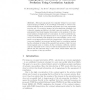Free Online Productivity Tools
i2Speak
i2Symbol
i2OCR
iTex2Img
iWeb2Print
iWeb2Shot
i2Type
iPdf2Split
iPdf2Merge
i2Bopomofo
i2Arabic
i2Style
i2Image
i2PDF
iLatex2Rtf
Sci2ools
BILDMED
2007
2007
Angiographic Assessment of Myocardial Perfusion Using Correlation Analysis
Abstract. Although angiography was originally designed as a morphological imaging modality, it is increasingly demanded to retrieve functional information from conventional angiograms. As X-ray angiography provides only 2D projection images, its most significant advantage over volumetric imaging modalities is its high temporal resolution. Thus the angiographic functional imaging relies mainly on the analysis of the temporal variation of single pixels or local regions. In order to assess the myocardial perfusion, the myocardium has to be recognized at first. This can be solved similarly with analysis of the time-intensity curves. Compared to most approaches in which the characteristic of the time-intensity curves are classified, our proposed method based on correlation analysis has the advantage of using all the sampled data points so that it is more robust against noise or outliers. As the correlation coefficient considers only the colinearity of two curves, we add the information a...
Algorithms | BILDMED 2007 | Morphological Imaging Modality | Time-intensity Curves | Volumetric Imaging Modalities |
| Added | 29 Oct 2010 |
| Updated | 29 Oct 2010 |
| Type | Conference |
| Year | 2007 |
| Where | BILDMED |
| Authors | Yu Deuerling-Zheng, Jan Boese, Stephan Achenbach, Josef Ludwig |
Comments (0)

